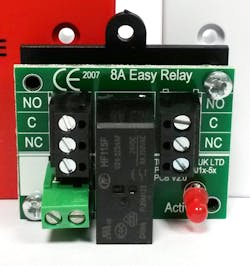When it comes to electronics, it seems like a relay is such a simple device – yet, it is able to interface some pretty elaborate high-end systems with a fire alarm system. Working with relays is an essential skill for fire alarm technicians, and two important aspects are understanding relay basics as well as two types of occupancies where a fire alarm installation will need to be interfaced with a high-end system.
Relay Basics
Relays have two terminals used to power its electromagnetic coil. Connecting power to the relay’s coil will cause the “common” terminal to be switched. Disconnecting this power will cause them to be switched back to “normal.”
The “normal” state of the electrical contacts is how the relay comes right out of the box. Confusion can arise when a technician implies the “normal” condition is the state of the relay terminal as it is being used; however, the working condition of the relay is not necessarily related to how its terminals are marked. For example, to power door holder electromagnets, you use the “common” and the “normally open” relay terminals. When you supply power to the relay, you complete an electrical path to the electromagnetic door holder by closing the electrical path between the “normally open” terminal and “common” terminal.
The confusion comes from providing a closed circuit to another trade or fire safety function by using the “normally open” relay contacts. You can avoid this confusion with theater, audio, elevator or the lighting contactors by simply telling them you “will be providing a relay with both open and closed contacts” and omit any reference to “normally open” or “normally closed.”
Knowledge into Practice
If you lack confidence in landing a larger job like a zoo, large church, hotel/conference center, college facility, or a multi-screen theater, don’t worry, a relay will make it much easier to interface with these venues’ high-tech systems.
Mega-church or assembly venue: These facilities generally include multiple large rooms and smaller areas that are served by a high-end sound system used for background music, paging, live music, as well as the occasional sermon.
Elaborate sound systems may use a server and software to pre-program each room’s sound settings. The audio technician programming the software for these systems will be able to shut down competing audio so that emergency instructions or warnings can be clearly recognized by all in attendance, including the pastor, choir, and musicians. One such audio GUI product is the Halogen configuration software from Rane Corp. (http://rane.com) – a detailed setup program that runs on a laptop or in-house PC. Rane’s site is an outstanding example of product support for the contractor wishing to get to the next level.
As the fire alarm contractor for this venue, you will need to provide a relay – as outlined in the first section – that is wired, powered and ready to be activated by an alarm from the fire alarm system. Don’t worry – you will not have to wire it to the system of another trade; in fact, yours may be but one general purpose input (GPI) point that must be configured using the audio technician’s software. That being said, just because another technician will provide the fire alarm relay output with control over the audio/video or lighting system, doesn’t mean you have to be totally in the dark about how it is accomplished and what can go wrong, even with a proper relay interface.
Rane’s programming software, for example, involves dragging and dropping each individual audio circuit (room name) onto the “fire alarm output” to provide the needed audio shut-down. Again, you will not be providing the wiring or programming, just the operational relay; however, you should know that the audio site configuration programmer might miss the “crying room” or “narthex” when dragging each audio zone onto the list of areas needing to be silenced during a fire alarm emergency.
After you notice your relay has been wired into the terminals on the rear of their equipment, you must still verify the life-safety audio shutdown function is working properly. Software may still prevent a properly functioning relay from providing each and every fire alarm evacuation zone with muted audio.
Multiplex theaters: Today, high-tech servers are common in modern digital movie theaters. Sony uses a digital server with a monitor, keyboard and mouse to provide control of all the screens and many functions available for operating a modern multiplex theater.
Sony knows theaters may use a switch or pushbutton to control house lights and to open/close curtains during a showing. To integrate easily with other systems, it provides general purpose input and output (GPIO) pins.
With Sony, the “Emergency Alert” function is performed with an input between the “common” terminal and “Pin #1” located on the rear of the projector server. Just as with an advanced audio system, it is still controlled by on-site software programming. Pin #1 must first be “Enabled” on the GUI’s “Maintenance” tab. Later, the programmer must then associate an input on Pin #1 with the “Emergency Alert” output function to the projectors.
If they don’t click “apply” when leaving a screen, site-specific software may still prevent a properly functioning fire alarm relay from providing the results you are looking for – to pass an acceptance test.
Advanced programmable lighting systems: Another popular interface available for integration with a fire/security alarm system, lighting controls from Eaton will have a dedicated fire alarm input terminal that provides emergency override.
This feature overrides all the custom programmable settings so that all the interior – and possibly exterior – lights will come on, full brightness, during a break-in or fire. Police and fire departments love this, so be sure to offer a relay output for controlling this non-required auxiliary function where you are installing a life safety system.
Even larger server-based networked lighting systems can still receive the “override” signal during an emergency by using Eaton’s special network interface module that allows your simple relay closure to initiate the emergency signal over their lighting network.
Greg Kessinger has been SD&I’s fire alarm and codes expert and a regular contributor for more than 15 years. Please email him your fire & life safety questions for potential inclusion in this column at [email protected].


